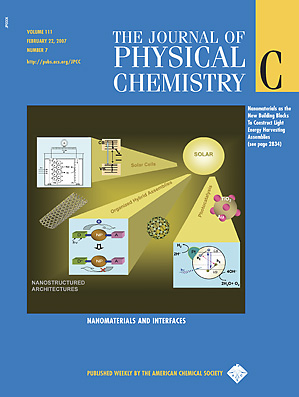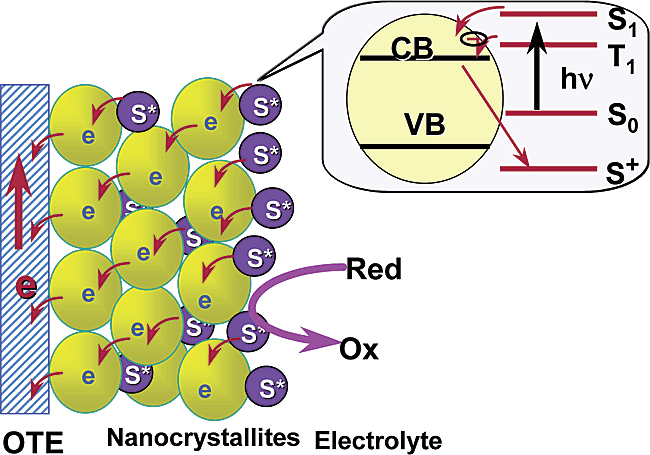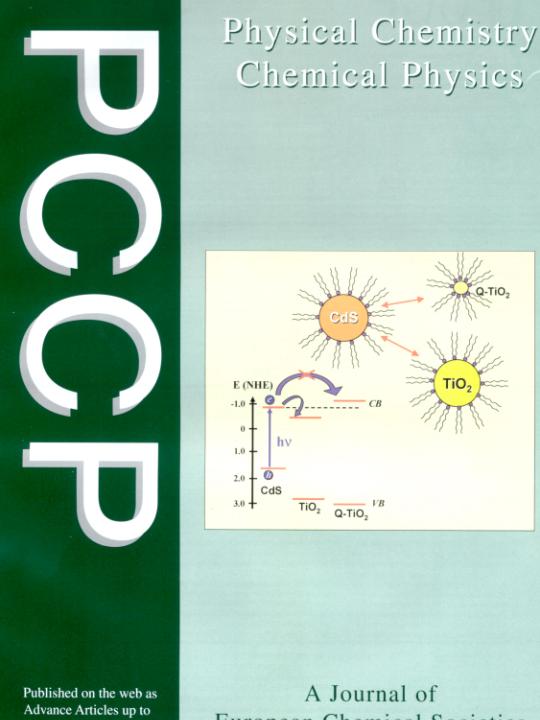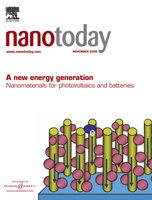- The Energy Challenge
- Clean Energy Alternatives
- Exploring Nanotechnology for Solar Energy Conversion
- Building a dye-sensitized solar cell (useful for student demonstration)
- Research Focus at Notre Dame (pdf) (PPS file-6MB)
- Watch "Delicious Solar Cell" made with donuts and tea by Blake Farrow Youtube ACS-Nanotube
- A Performance Calculator for Grid-Connected PV Systems
- View a PBS-NOVA show "Saved by the Sun"
- Solar Energy - Beyond the Hype (Power Point 11 MB) (pdf 5MB)

Review article on a energy conversion topic (ready reference with 350+ citations)
Meeting the Clean Energy Demand: Nanostructure Architectures for Solar Energy Conversion
J. Phys. Chem. C, 111 (7), 2834 -2860, 2007. http://dx.doi.org/10.1021/jp066952u
During the last decade the nanomaterials have emerged as the new building blocks to construct light energy harvesting assemblies. Organic and inorganic hybrid structures that exhibit improved selectivity and efficiency towards catalytic processes have been designed. Size dependent properties such as size quantization effects in semiconductor nanoparticles and quantized charging effects in metal nanoparticles provides the basis for developing new and effective systems. These nanostructures provide innovative strategies for designing next generation energy conversion devices. Recent efforts to synthesize nanostructures with well defined geometrical shapes (e.g., solid and hollow spheres, prisms, rods, wires) and their assembly as 2- and 3- dimensional assemblies has further expanded the possibility of developing new strategies for light energy conversion.
There are three major ways that one can utilize nanostructures for the design of solar energy conversion devices. The first one is to mimic the photosynthesis with donor-acceptor molecular assemblies and clusters. The second one is the semiconductor assisted photocatalysis to produce fuels such as hydrogen. The third and most promising category is the nanostructure semiconductor based solar cells. Strategies to employ ordered assemblies of semiconductor and metal nanoparticles, inorganic-organic hybrid assemblies and carbon nanostructures in the energy conversion schemes are currently being explored in our laboratory.
See Popular Presentations on Meeting the Clean Energy Challenge with Nanotechnology or Solar Energy - Beyond the Hype (11 MB)
Robel, I., Subramanian, V., Kuno, M. and Kamat, P. V., Quantum Dot Solar Cells. Harvesting Light Energy with CdSe Nanocrystals Molecularly Linked to Mesoscopic TiO2 Films. J. Am. Chem. Soc., 2005, 2385-2393
Read one of 5 most cited papers on solar cells during last 2 years (ISI Web of Knowledge)
Hasobe, T., Imahori, H., Kamat, P. V. and Fukuzumi, S., Photovoltaic Cells using composite nanoclusters of porphyrins and fullerenes with gold nanoparticles. J. Am. Chem. Soc, 2005, 127, 1216-1228.
Our Research Focus.
To design heterogeneous assemblies consisting of carbon nanostructures (fullerenes, carbon nanotubes
 etc) , semiconductor nanostructures, metal particles
and
sensitizing dyes for harvesting light energy
etc) , semiconductor nanostructures, metal particles
and
sensitizing dyes for harvesting light energy-
To elucidate the interfacial charge transfer processes in semiconductor/sensitizer systems.
-
To improve photoinduced charge separation in donor-acceptor type dyads and triads by binding them to metal nanostructures and/or semiconductor composites
-
To employ donor-acceptor based supramolecular systems (for example, fullerenes and porphyrins) and molecular clusters for in organic photovoltaic cells.
Recent
Progress
- Pioneered in the elucidation of interfacial charge transfer
processes and introduction of composite semiconductor systems for
improving the performance of dye sensitized solar cells
- Probed
the role of iodide and triiodide ions in deactivating the excited state
of Ru(II)polypyridyl complex bound to TiO2.
- Established the role of Fermi level equilibration in improving the energetics of semiconductor-metal systems. A shift of 100-150 mV in the apparent Fermi level was achieved by depositing 2-3 nm Au nanoparticles on TiO2 nanostructures.
- Achived a photoconversion efficiency (IPCE ) of 60% and power conversion effeciency of 2% using Au-Porphyrin_C60 based molecular clusters.
- Designed inorganic-organic hybrid assemblies for photoelectrochemical conversion of light energy
- Employed cabon nanotubes as conduits to promote chargeseparation and charge transport in nanostructured semiconductor films
Recent
Publications
Hasobe, T.; Fukuzumi, S.; Kamat, P.V., Stacked-Cup Carbon Nanotubes for Photoelectrochemical Solar Cells. Angew. Chem. (Int. Ed.), 2006. 45, 755-759. http://dx.doi.org/10.1002/anie.200502815 NDRL 4623 Hasobe, T.; Hattori, S.; Kamat, P.V.; Fukuzumi, S., Supramolecular nanostructured assemblies of different types of porphyrins with fullerenes using TiO2 nanoparticles for light energy conversion. Tetrahedron, 2006. 62, 1937-1946. http://dx.doi.org.lib/10.1016/j.tet.2005.05.113 NDRL 4606
Robel, I., Bunker, B. and Kamat, P. V., SWCNT-CdS nanocomposite as light harvesting assembly. Photoinduced charge transfer interactions. Adv. Mater., 2005, 17, 2458-2463. (doi:10.1002/adma.200500418) NDRL 4583
Kamat, P.
V., Photoelectrochemistry in Particulate Systems. 9. Photosensitized
Reduction in a Colloidal Tio2 System Using Anthracene-9-Carboxylic Acid
as the Sensitizer. J. Phys. Chem., 1989. 93 859-64.
Bedja, I., S. Hotchandani and P. V. Kamat, Preparation and Characterization of Thin Sno2 Nanocrystalline Semiconductor Films and Their Sensitization with Bis(2,2'-Bipyridine)(2,2'-Bipyridine-4-4'-Dicarboxylic Acid)Ruthenium Complex. J. Phys. Chem., 1994. 98 4133-4140.
Fessenden,
R. W. and P. V. Kamat, Rate Constants for Charge Injection from Excited
Sensitizer into SnO2, ZnO, and TiO2
Semiconductor Nanocrystallites. J. Phys. Chem., 1995. 99 12902-12906.
Sudeep, P.
K., Ipe, B.
George
Thomas, K. and Kamat, P. V., Chromophore Functionalized Gold
Nanoparticles.
Acc. Chem. Res., 2003, 36, 888-898 (Review Article)
Kamat, P. V., I. Bedja,
S. Hotchandani and L. K. Patterson, Photosensitization of
Nanocrystalline Semiconductor Films. Modulation of Electron
Transfer between Excited Ruthenium Complex and Sno2 Nanocrystallites
with an Externally Applied Bias. J. Phys. Chem. B, 1996. 100
4900-4908.
Nasr, C., S. Hotchandani,
W. Y. Kim, R. H. Schmehl and P. V. Kamat, Photoelectrochemistry of
Composite Semiconductor Thin Films. Photosensitization of SnO2/CdS
Coupled Nanocrystallites with a Ruthenium Complex. J. Phys. Chem. B,
1997. 101 7480-7487.
Liu, D., P. V. Kamat, K.
George Thomas, K. J. Thomas, S. Das and M. V. George, Picosecond
Dynamics of an Ir Sensitive Squaraine Dye. Role of Singlet and Triplet
Excited States in the Photosensitization of TiO2
Nanoclusters. J. Chem. Phys., 1997. 106 6404-6410.
Das, S. and P. V. Kamat,
Can Dye Aggregates Serve as Light Harvesting Antenna? Triplet-Triplet
Energy Transfer between Excited Aggregates and Monomer in Aot/Heptane
Solutions. J. Phys. Chem. B, 1999. 103 209-215..
Kamat, P. V., S.
Barazzouk, K. George Thomas and S. Hotchandani, Electrodeposition of C60
Clusters on Nanostructured SnO2 Films for Enhanced
Photocurrent Generation. J. Phys. Chem. B, 2000. 104 4014-4017.
Kamat, P. V., M. Haria
and S. Hotchandani, C60 Cluster as an Electron Shuttle
in a Ru(Ii)-Polypyridyl Sensitizer Based Photochemical Solar Cell. J.
Phys. Chem. B, 2004. 108 5166-5170.
Hasobe, T., H. Imahori, P. V. Kamat and S. Fukuzumi, Photovoltaic Cells Using Composite Nanoclusters of Porphyrins and Fullerenes with Gold Nanoparticles. J. Am. Chem. Soc, 2004. 126 in press.
In
Popular Press
Reactive Reports: Fullerenes
on Film
   
|
Highlights
in
Robel, I.;
Subramanian, V.; Kuno, M.; Kamat, P.V., Quantum Dot Solar Cells.
Harvesting Light Energy with CdSe Nanocrystals Molecularly Linked to
Mesoscopic TiO2 Films. J. Am. Chem. Soc., 2006.
128, 2385-2393.
Materials Today December 2004 Research News-Nanotoday Supplement New Light on CNT's -Energy Generation